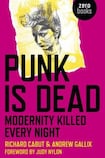
Last October, Trinity College Dublin hosted a symposium marking the 40th anniversary of the night The Clash played a pair of incendiary gigs in the ornate setting of the Examinations Hall. Perhaps the star turn of an entertaining day was Don Letts, a prime mover in the London punk scene from which the band emerged. Liberated by a roving microphone, Letts paced among a captive audience comprised overwhelmingly of men of a certain age.
At one point, the DJ and film-maker invited the gathering to reflect on the incongruity of the moment we were sharing. While one of its principal animating impulses was an unforgiving iconoclasm, punk had from the outset insisted upon hushed reverence for the endless sequence of commemorations staged to honour its own relics and martyrs. Pausing for effect and somehow looking everyone in the eye simultaneously, Letts insisted that the audience consider that particular irony by saying something previously presumed to be unsayable: Why are we still talking about all this?
In the four decades since Steve Jones turned the air blue on the Bill Grundy Show, it has often been hard to avoid some sentiment that approximates to the faux exasperation Don Letts staged in the cloisters of Trinity College. As the 40th anniversary of pop culture’s Year Zero has come and passed, the steady stream of cultural texts devoted to punk has inevitably gathered pace.

Among the books that have emerged to mark the moment is Punk is Dead: Modernity Killed Every Night, an anthology of no fewer than 28 essays and interviews collated by the author and musician Richard Cabut and the academic and founder of 3:AM Magazine Andrew Gallix. Despite its funereal title, the editors of the collection make it clear that they are here not to bury punk but rather to praise it. In their bifurcated introduction, Cabut and Gallix retrace their own steps to a time in which they evidently remain heavily invested personally. The specific purpose of the book is to celebrate that original evanescent wellspring of creativity when punk emerged as a "stylish boho response to the modern world of inertia and consumption" and retained the "innocence characteristic of childhood" of a movement yet to be frozen by being named or sullied by exposure to popular vitriol and acclaim alike.
Prohibition against nostalgia
In their framing of this uneven but valuable collection of paeans to punk’s formative prelapsarian moment, the editors claim that there exists at present a widespread prohibition against nostalgia. Cabut and Gallix cast their book as an attempt to break this embargo, specifically to make the case that “punk’s cultural importance should . . . be officially recognised in museums and galleries.”
It would of course be hard to think of a characterisation that sits more at odds with contemporary cultural realities. An overwhelming imperative of the culture industries for several decades now has, after all, been to purloin the styles and personalities of what were once discrete moments in the past and to splice and recycle these in what can only barely the summon the energy to call itself the present. From the moment of its inception, punk was both a herald and an accelerant of the proclivity towards pastiche central to late capitalism. The cultural treasure of the movement has in fact long since been officially recognised in museums and galleries all over the world.
The only surprise when discovering that the long-running McDonald’s campaign is scored by a Buzzcocks classic and pilfers the ransom-note font beloved of the Blank Generation is that it not longer surprises. Those everyday artefacts of a mythical, lost England that were once subject to the détournement of Jamie Reid and others – the safety pin, the saucy knotted hanky, the tributes to the House of Windsor – are now cherished exhibits in the cultural mausoleum being erected apace across the water in Brexitannia.
Deadening shadow
The deadening shadow that punk – and its endless commemoration – has in fact cast over popular culture was diagnosed most adroitly perhaps by a gifted cultural theorist who appears in this collection but is, alas, under-used. In Ghosts of My Life (2014), the late Mark Fisher noted that its veneration of the past has deprived contemporary pop music of that capacity for "future shock" that was once its calling-card. While Fisher's insistence that popular culture today is haunted by former glories is often persuasive, he fails crucially to acknowledge the culpability of those of us who came of age at a time when killing modernity every night still sounded progressive in creating this miserable state of affairs.
The insistence of our generation on the singular and timeless importance of punk has eroded the cultural space available to younger people facing the lash of neoliberal discipline in ways that we could never have imagined. It might then be long past the time that those of us whose worldview has been so long intertwined with the subculture gave up the ghosts that stalk the past and began helping to summon the spectres that, hopefully, haunt the future. This will of course require that we face finally that difficult question posed recently in these parts by someone best placed to judge these matters: No really, why are we still talking about all this?
Colin Coulter lectures in sociology at Maynooth University











